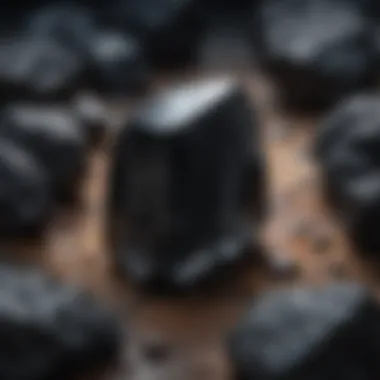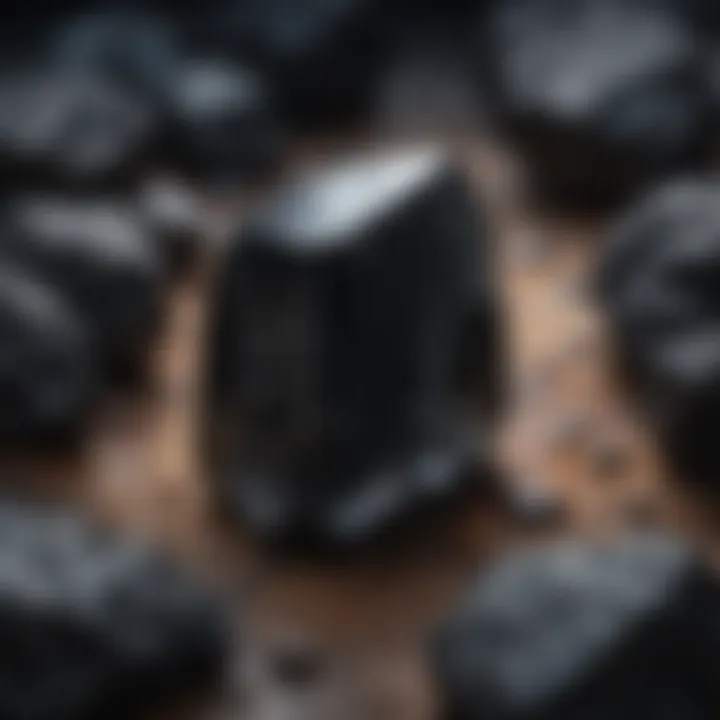Exploring the Unique Properties of Australian Black Tourmaline


Intro
Australian black tourmaline, a striking and multifaceted mineral, deserves attention from collectors and enthusiasts alike. This unique gemstone, known for its deep black hue and remarkable properties, offers a rich tapestry of history and cultural significance. Understanding its geological origins and applications provides insight into its value, both aesthetically and scientifically.
In this exploration, we will navigate the various aspects of Australian black tourmaline, from its formation in the Earth's crust to its identification and classification. This narrative seeks to unravel the complexities of this intriguing mineral, shedding light on its importance within the broader context of geology and mineralogy.
History and Origins
Overview of Collectibles, Rocks, and Fossils
Australian black tourmaline is part of a larger collection of minerals that captivate those interested in geology. As a member of the tourmaline group, its formation can be traced back to magma crystallization in igneous environments. This process is what gives the mineral its unique structure and properties.
Collectors often seek black tourmaline not only for its visual charm but also for its metaphysical associations. Believed to have grounding energy, it has become popular among crystal healers. The origins of tourmaline date back millions of years, and Australian deposits offer a rich source for enthusiasts.
Historical Significance and Cultural Impact
Throughout history, black tourmaline has played a multifaceted role in various cultures. Indigenous Australian tribes have historically revered this mineral, believing it to have protective properties. It symbolizes strength and power in some Aboriginal cultures. The allure of this gemstone transcended its practical applications, entering the realm of cultural and spiritual significance.
During the 19th and 20th centuries, the rise of the mineral collecting hobby helped foster a deeper appreciation for black tourmaline. As collectors formed societies and exhibitions, the value of these minerals increased.
Black tourmaline is not just a rock; it represents a deep connection to Earth's history and human culture.
The understanding of these historical contexts enriches our appreciation for Australian black tourmaline. Each specimen comes with a narrative interwoven through geological processes and human experience.
Identification and Classification
Guide to Identifying Rocks and Fossils
Identifying Australian black tourmaline involves several key characteristics. The mineral typically exhibits a shiny, glassy luster and can appear in various forms, including crystals or rough chunks. When examining the surface, one should look for characteristic striations along the crystal faces, a clear indicator of its identity.
A meticulous approach to collection and identification aids in verifying the authenticity of black tourmaline. Color intensity can vary, but true specimens are often a deep, uniform black. Collectors should also be aware of variations within the tourmaline group, as they might encounter green, blue, or even pink tourmaline.
Common Types and Variations
While black tourmaline is distinctive, there are various types and classifications within the tourmaline family. Some commonly recognized forms include:
- Schorl: The most common black tourmaline variety, it often serves as a benchmark for other types.
- Elbaite: This variation can display striking multi-colored features, offsetting the uniformity of black.
- Dravite: While typically brown or black, this type also shares characteristics with schorl.
Recognizing these distinctions aids collectors in navigating the expansive world of tourmaline. Each type reveals unique historical data and geological processes, deepening the fascination with this mineral.
Prolusion to Australian Black Tourmaline
Australian black tourmaline is an intriguing mineral that has drawn the attention of both collectors and enthusiasts. This introduction discusses the significance of this stone in various contexts, including its geological and cultural relevance. Understanding Australian black tourmaline opens avenues to appreciate not only its physical properties but also its historical and social impacts on communities.
Definition and Overview
Black tourmaline, specifically the Australian variety, is a member of the tourmaline family, recognized for its unique color and electrifying properties. Chemically, it is composed mainly of boron, aluminum, and silicon, among other elements. The striking black hue is due to the presence of iron and other transition metals. This mineral is not only valued as a gemstone but also appreciated for its metaphysical attributes.
Australian black tourmaline is primarily sourced from regions like New South Wales and Queensland. The global demand for gemstones has increased interest in Australian black tourmaline, emphasizing its importance in the market. Moreover, its properties make it useful in various applications, making it even more relevant in discussions of geology and mineralogy.
Historical Context
The history of black tourmaline in Australia can be traced back to the Indigenous cultures who recognized its significance long before European colonization. Many Aboriginal communities used this stone in traditional practices for its believed protective qualities. These historical insights contribute to a broader understanding of the mineral's cultural value.
During the late 19th and early 20th centuries, black tourmaline gained recognition among mineral collectors and gem enthusiasts. Notably, the introduction of modern mining techniques improved access to quality specimens, leading to an increased appreciation for this mineral. This shift marked a new era for Australian black tourmaline, firmly establishing its place in the realm of rock and fossil collecting.


Geological Formation of Black Tourmaline
Understanding the geological formation of black tourmaline is crucial in appreciating its unique attributes and applications. This section delves into the intricate processes that create this mineral, beginning from its composition to the environmental factors influencing its existence. The formation of Austrlalian black tourmaline is not only important for geology enthusiasts, but also for collectors who wish to understand the origins of the specimens they obtain. Knowledge of these factors can greatly influence valuation and collecting strategies.
Mineral Composition
Australian black tourmaline primarily consists of a complex mix of elements, including sodium, lithium, aluminum, boron, and silica. Its chemical formula is often represented as NaFe²⁺₃Al₆(BO₃)₃Si₆O₁₈(OH)₄. This diversity in elements results in the mineral’s distinctive physical properties, such as its striking black coloration and vitreous luster.
The presence of iron is significant. It imparts desirable features like durability and attractiveness. Tourmaline forms through a crystallization process and can also take on various colors based on its elemental inclusions. Tthe black variety, particularly beloved among collectors, is a result of iron and manganese content. As such, the mineral composition not only defines its aesthetic appeal but also its functionality.
Formation Conditions
Black tourmaline typically forms in igneous and metamorphic rocks under specific temperature and pressure conditions. These minerals crystallize from a hot, molten magma rich in boron, which can occur during the cooling of granite. Additionally, metamorphic processes can transform other minerals into tourmaline, particularly during regional metamorphism.
Certain metamorphic environments, especially those that feature high boron concentrations, are conducive to the formation of black tourmaline. The geological history of Australia includes events that shaped its terrain, providing a fertile ground for these conditions. Understanding where and how these elements come together allows geologists and collectors alike to predict potential locations for finding quality specimens.
Distribution in Australia
Australia is home to some of the world's most notable deposits of black tourmaline, primarily located in the states of New South Wales and Queensland. The distribution of this mineral is often linked to geological events such as volcanic activities or the presence of specific rock formations.
In New South Wales, deposits can be found in regions such as the Himalaya Mine, which is noted for its exceptional tourmaline varieties. Meanwhile, Queensland hosts many pegmatite dikes rich in tourmaline. These locations are popular among both amateur and professional collectors seeking unique specimens. The distinct geological characteristics of areas within Australia contribute to the quality and variety of black tourmaline.
"The understanding of black tourmaline's geological roots enhances its appeal, not just as a collectible but also as a fascinating study of geology itself."
Physical Characteristics
The physical characteristics of Australian black tourmaline hold great importance in understanding its overall value and desirability. Collectors and enthusiasts should pay attention to specific attributes such as color, hardness, cleavage, and crystal structure. With this knowledge, one can evaluate the quality and potential applications of this mineral more effectively. Each characteristic contributes not only to its aesthetic appeal but also to its functionality in different contexts.
Color and Transparency
The color of Australian black tourmaline typically ranges from deep black to shades of dark green or brown. This range occurs due to various trace elements present during its formation. One notable feature of black tourmaline is its opacity, which contributes to its striking appearance. While many gemstones thrive on transparency, the dense hues of tourmaline offer a unique charm. The rich colors are often consistent throughout, making it visually appealing for both collectors and jewelry designers. Additionally, the uniform coloration can enhance the stone's perceived value.
Hardness and Cleavage
Black tourmaline is respected for its hardness, which rates between 7 and 7.5 on the Mohs scale. This level of hardness makes it suitable for various applications, such as in jewelry where durability is essential. Higher hardness means the stone can resist scratching and wear better than softer materials. This characteristic is particularly desirable for pieces intended for everyday use.
When it comes to cleavage, black tourmaline does not exhibit perfect cleavage. Instead, it shows uneven fracture. This factor influences the cutting and shaping processes when creating jewelry. A gem cutter must understand these aspects to maximize the tourmaline's aesthetic appeal while minimizing waste.
Crystal Structure
The crystal structure of Australian black tourmaline is a focal point in understanding its properties. Black tourmaline typically forms in elongated prismatic crystals, displaying a complex boron-rich structure. This unique arrangement contributes to its robust nature and various beneficial attributes. The crystals can exhibit striations, enhancing their visual interest.
The arrangement of its atoms allows tourmaline to have piezoelectric and pyroelectric properties, making it significant in both technological and alternative domains. These properties are particularly useful in settings that require the conversion of pressure or heat into electric energy. Understanding the crystal structure also assists in identifying the authenticity of black tourmaline in the market.
Understanding the physical characteristics of black tourmaline not only enriches the appreciation of this unique mineral but also informs collectors and enthusiasts of its varied applications.
Cultural Significance
The cultural significance of Australian black tourmaline extends beyond its physical properties and aesthetics. It embodies a rich tapestry of traditions and beliefs, particularly among Indigenous communities and those embracing alternative therapies. Understanding these dimensions adds depth to our appreciation of this mineral.
Indigenous Australian Perspectives
For Indigenous Australians, black tourmaline holds a profound place in their cultural practices. The mineral is often perceived as a protective stone, guarding against negative energies and promoting emotional stability. Many Indigenous groups believe that it can serve as a conduit for personal empowerment. This idea is rooted in their connection to the land and the spiritual dimensions they attribute to natural elements.
Historically, Aboriginal communities have used various minerals and stones in rituals and ceremonies. Black tourmaline may have played a role in these traditional practices, though specifics can vary widely from one group to another. The connection to the land is paramount; thus the collection and use of stones are often done with deep respect and understanding of their cultural significance.
Moreover, some stories and teachings highlight the importance of black tourmaline in storytelling, symbolizing resilience and strength. This cultural narrative continues to inspire contemporary practices, celebrating the innovative use of local resources while honoring ancestral wisdom.


Use in Alternative Therapies
In modern wellness practices, Australian black tourmaline is often used in alternative therapies. Practitioners believe that it possesses unique healing properties. Many claim it can absorb negative energy, making it a popular choice for energy healing and meditation. Integrating this mineral into spiritual practices can enhance one’s mental clarity and emotional wellbeing.
The stone is also regarded for its grounding qualities. Many people incorporate it into their meditation spaces, where it supposedly aids in establishing a calm, focused environment. This aspect of tourmaline is especially appealing to those seeking refuge from the stressors of daily life.
Furthermore, its purported benefits in balancing the chakras contribute to its popularity in holistic healing. Therapists often recommend it for those experiencing anxiety, offering it as a tool for releasing negative emotions.
In summary, the cultural significance of Australian black tourmaline encompasses a variety of perspectives, from Indigenous practices that emphasize connection and respect for the land, to contemporary alternative therapies that harness the stone's perceived healing abilities. This multifaceted understanding elevates the importance of this mineral, illustrating its value beyond mere aesthetics.
Applications of Australian Black Tourmaline
The applications of Australian black tourmaline are diverse and significant. This mineral is not just valued for its aesthetic appeal but also for its various practical uses. Understanding these applications allows collectors and enthusiasts to appreciate this stone beyond its visual characteristics. From jewelry to industrial settings, black tourmaline plays an essential role in multiple areas of life. Its importance lies not only in its beauty but also in its potential utility and effects.
Jewelry and Decorative Uses
In the realm of jewelry and decorative arts, Australian black tourmaline shines as a popular choice. Its striking black hue blends well with various metals, making it appealing for rings, necklaces, bracelets, and earrings. Many artisans and designers favor this stone for its durability and unique look. The polished finish enhances its natural luster and provides a sophisticated touch.
- Versatile Designs: Jewelers can create intricate designs because of its hardness, which rates between 7 to 7.5 on the Mohs scale. This ensures that pieces remain intact over time.
- Symbolism: Many wear black tourmaline as a symbol of protection. The belief is that it repels negative energies, making it a meaningful adornment.
- Market Trends: There is a growing trend among consumers who seek ethically sourced materials. Australian black tourmaline, when sourced responsibly, fits within this category, appealing to conscientious buyers.
Industrial Applications
Beyond aesthetics, Australian black tourmaline finds a place in several industrial applications. Its unique physical properties make it suitable for various practical uses.
- Manufacturing Materials: Black tourmaline is utilized in the production of certain industrial ceramics and glass due to its thermal and electrical insulation properties.
- Electronics: Its piezoelectric properties allow it to be used in specific electronics applications, providing potential for innovation in tech industries.
- Environmental Applications: The mineral's capability for absorbing electromagnetic radiation makes it a viable option for creating environmentally friendly products, helping to reduce unwanted energies in various settings.
Energy and Healing Properties
There is a significant interest in the energy and healing properties attributed to Australian black tourmaline. Many holistic practitioners promote its use for various healing purposes.
- Negative Ion Generation: It can emit negative ions, which some studies suggest can help improve overall well-being and reduce stress.
- Emotional Healing: Practitioners often encourage using black tourmaline for emotional healing, believing it to assist in overcoming anxiety and fear, helping in personal growth.
- Physical Benefits: It is believed to have the potential to detoxify the body and improve physical health by stimulating blood circulation and protecting the immune system.
It is crucial to note that while many advocate for the healing benefits of black tourmaline, scientific evidence is limited. Users should approach these claims with discernment and consider them as complementary to conventional medicine.
"Australian black tourmaline serves as a multifaceted gem that seamlessly integrates into both the beauty and functionality of modern life."
In summary, the applications of Australian black tourmaline encompass a wide range of uses. From its pivotal role in jewelry design to its significant industrial applications and healing properties, this mineral showcases versatility and value. Collectors deeply engaged in the mineralogical world can find multiple reasons to appreciate and incorporate black tourmaline into their collections.
Collecting Australian Black Tourmaline
Collecting Australian black tourmaline is a fascinating endeavor. For enthusiasts and collectors alike, understanding this mineral's unique qualities and market value is essential. Black tourmaline, particularly from Australia, offers aesthetic appeal and potential investment value. The pursuit of these stones requires careful consideration of various factors, including identification techniques and current market trends.
Identification Techniques
Identifying Australian black tourmaline can be an intricate process. Collectors should be aware of its visual characteristics and geological origins. Key elements in identification include:
- Color and Transparency: Australian black tourmaline typically has a deep black hue, sometimes with shades of dark green. Transparency can vary, with some specimens exhibiting a glassy luster.
- Physical Tests: Using tools such as a refractometer can help in evaluating the stone's refractive index, confirming its authenticity.
- Crystal Structure: Familiarity with the columnar or prismatic habit of black tourmaline is crucial. The unique striations found on the surface can also aid in distinguishing it from other minerals.
"Understanding subtle variations in mineral properties enables collectors to make informed decisions, ensuring their collection remains authentic and valuable."
Finding unblemished pieces and recognizing signs of enhancement or treatment can add to the skill set of any collector. Knowledge about the region from which the stone originates can provide insights into its quality and rarity. Engaging with other collectors can be helpful. Online forums and local gem shows often provide opportunities to share knowledge about rare finds.
Valuation and Market Trends
The valuation of Australian black tourmaline is influenced by several factors. These include size, clarity, color integrity, and demand within the collector community. Recent trends show an increasing interest in natural gemstones, elevating black tourmaline's status in the market.
Factors affecting valuation include:


- Market Demand: As more people become aware of the benefits and beauty of black tourmaline, demand increases, impacting prices.
- Quality Assessments: Certifying agencies such as GIA (Gemological Institute of America) offer grading services that can enhance the marketability of a stone.
- Comparative Values: Understanding how Australian black tourmaline compares to similar stones in value can assist in negotiating purchases or sales. Prices of well-preserved pieces can reach significant amounts, reflecting their rarity.
Collectors need to stay updated on market fluctuations and attend gemstone expos or events to ascertain the prevailing conditions. Consistent research and engagement with the collecting community can provide insights into where the market may be headed in the future.
In summary, collecting Australian black tourmaline involves much more than mere acquisition. It is about understanding the unique identifiers of the Gems themselves and navigating the market effectively.
Care and Maintenance
Caring for Australian black tourmaline is essential for maintaining its appeal and value. Like many mineral specimens, adequate care ensures that the stone retains its natural beauty over time. As a collector or enthusiast, understanding how to properly clean and store your black tourmaline is vital. The right care will prevent damage and enhance its overall aesthetic. This section examines cleaning methods and storage recommendations tailored to the specific needs of this unique gemstone.
Cleaning Methods
Cleaning Australian black tourmaline requires gentle techniques to avoid scratching or dulling the surface. Here are some recommended methods:
- Mild soap solution: Mix a few drops of mild soap with warm water. Use a soft cloth or a non-abrasive brush to clean the surface, paying attention to crevices. Rinse thoroughly with clean water to remove any soap residue.
- Avoid harsh chemicals: Do not use bleach or other heavy-duty cleaning agents. These can be damaging to the mineral.
- Drying: After cleaning, gently pat the stone dry with a soft towel. Make sure to remove all moisture to prevent staining or deterioration.
- Regular maintenance: Frequent light cleaning can help keep the tourmaline looking its best. This can also help to maintain its luster and shine, making it more attractive in display or jewelry settings.
Always handle the stone with care during cleaning. The goal is to maintain its integrity while removing any dirt or oils that may accumulate over time.
Storage Recommendations
Proper storage is crucial for preventing damage and preserving the quality of Australian black tourmaline. Here are some guidelines:
- Soft pouch or cloth: Store the tourmaline in a soft pouch or wrap it in a cloth. This prevents scratches and reduces the risk of breakage.
- Avoid direct sunlight: Prolonged exposure to direct sunlight can fade some color variations. Store in a cool, dark place to maintain its vibrancy.
- Separate storage: If you own multiple minerals or gemstones, store them separately. Keeping black tourmaline apart from harder materials helps avoid scratches or abrasions.
- Humidity control: Ensure the storage area has stable humidity levels. Excess moisture can cause deterioration over time. Consider using silica gel packs to absorb moisture in the storage container.
In summary, proper care and maintenance of Australian black tourmaline significantly enhances its longevity and beauty. By following appropriate cleaning methods and storage techniques, collectors can enjoy their specimens for years to come without compromising their integrity.
Scientific Studies and Findings
Understanding the structural and elemental properties of Australian black tourmaline is important for several reasons. This mineral has diverse applications, from use in jewelry to its role in geology and healing practices. The scientific exploration of black tourmaline includes both mineralogical research and environmental impact studies. These investigations shed light on its unique characteristics and potential effects on ecosystems, promoting a holistic appreciation of this remarkable stone.
Mineralogical Research
Mineralogical research concerning Australian black tourmaline focuses on several aspects, including its crystallography, chemical composition, and the specific conditions that lead to its formation. Studies have shown that the mineral primarily consists of boron, aluminum, and silicate, with trace elements that can enhance its color and properties. This research is crucial because it informs collectors and scientists about the quality and stability of the mineral.
Additionally, researchers employ various techniques, such as X-ray diffraction and spectroscopy, to determine the crystal structure and arrangement of atoms within black tourmaline. Such analyses not only contribute to academic knowledge but also assist in assessing the mineral's provenance and authenticity.
"Understanding the mineral composition of black tourmaline informs collectors about its potential use and value."
Furthermore, Geological surveys in Australia have indicated the presence of black tourmaline in distinct regions, suggesting that its formation is influenced by specific geological processes. This knowledge helps geologists in mapping and exploring mineral resources.
Environmental Impact Studies
Environmental studies on black tourmaline address both the extraction processes from the earth and its implications for local ecosystems. As mining activities increase, it becomes crucial to assess how these actions affect the surrounding environment. Key concerns include habitat destruction, soil erosion, and water contamination.
Research has demonstrated that responsible mining practices can mitigate some adverse effects. For example, studies advocate for sustainable methods that minimize the environmental footprint, such as reforestation in mined areas. These efforts showcase how scientific inquiry not only highlights the importance of the mineral but also urges stakeholders to balance resource extraction with ecological preservation.
Furthermore, investigations into the uses of black tourmaline in various industries, including its role in filtration and electronics, illustrate its environmental benefits. For instance, its use in water purification systems can lead to positive ecological outcomes when implemented responsibly.
In summary, the ongoing scientific studies on Australian black tourmaline reveal its multifaceted value, from its geological origins to its environmental implications. For collectors and researchers alike, these findings offer important insights that enhance understanding and appreciation of this unique mineral.
The End
The examination of Australian black tourmaline underscores its significance in geological studies and individual applications. This article thoroughly discusses the unique aspects of the mineral, ranging from its geological formation to its cultural relevance. One must appreciate the complexity of black tourmaline, not only as a collectible mineral but also for its broader implications in understanding Earth’s history.
Summary of Key Points
- Geological Origins: Australian black tourmaline is shaped by specific conditions that involve extensive geological processes. Its mineral composition and the environment of formation play pivotal roles in its characteristics.
- Physical and Cultural Significance: The mineral is distinguished by its durability and unique aesthetics, making it popular in both jewelry and healing practices. Indigenous perspectives highlight traditional uses, offering insight into its cultural importance.
- Practical Applications: Beyond decorative purposes, this mineral finds a place in various industries due to its remarkable physical properties. Furthermore, its perceived energy and healing benefits attract interest from alternative therapy practitioners.
- Research Gaps: There remains an opportunity to explore the environmental impact of mining black tourmaline and its long-term sustainability, preliminary discussions suggest.
Future Directions in Research
Future research regarding Australian black tourmaline is necessary for various reasons. Firstly, there is limited comprehensive mineralogical research. Understanding the specific environmental factors influencing its formation can provide valuable insights into geological changes in Australia. Moreover, the demand for ethical sourcing within the mineral market also necessitates investigation. Researchers may focus on the sustainability practices within mining operations to ensure minimal environmental disruption.
Additionally, exploring the metaphysical claims associated with black tourmaline could attract scientific scrutiny. Further studies could benefit from examining the nuances of its application in therapy contexts and whether there are tangible health benefits. In summary, the future of research in Australian black tourmaline should embrace interdisciplinary studies, combining fields like geology, environmental science, and cultural anthropology.



